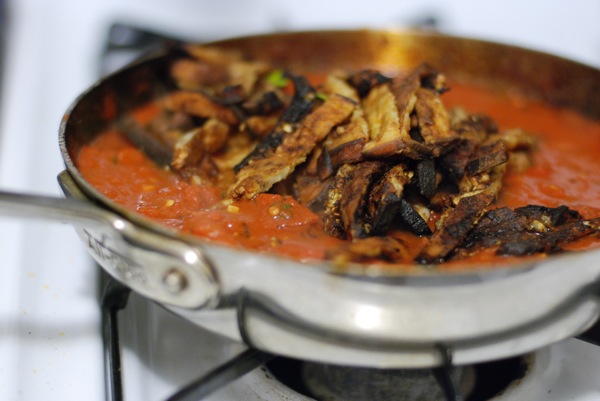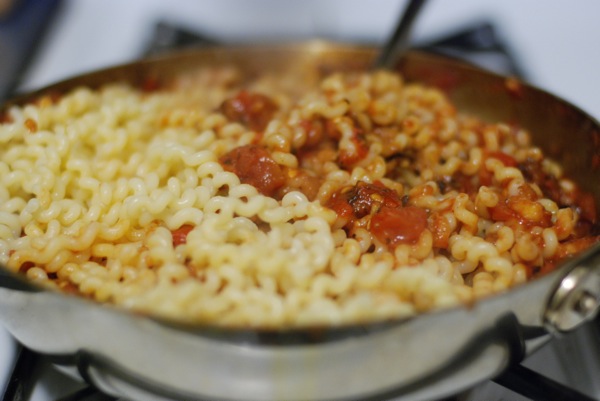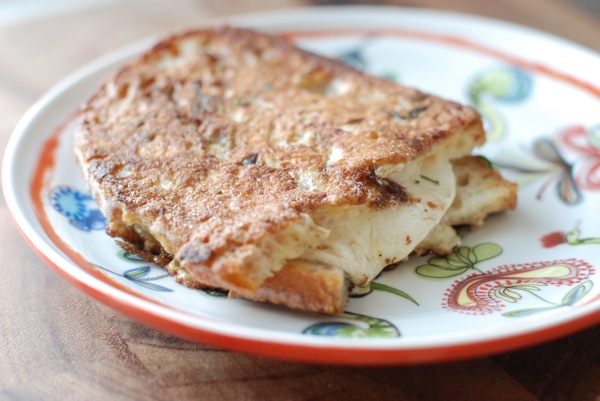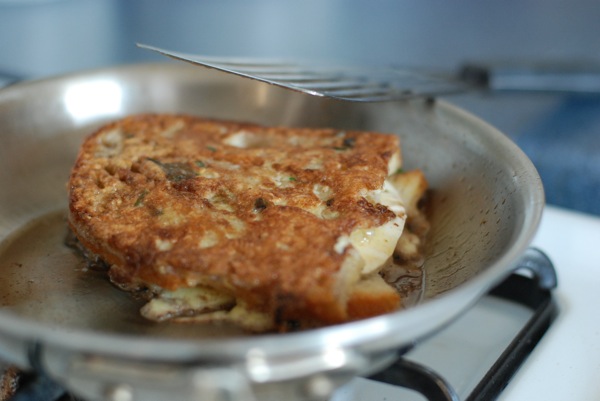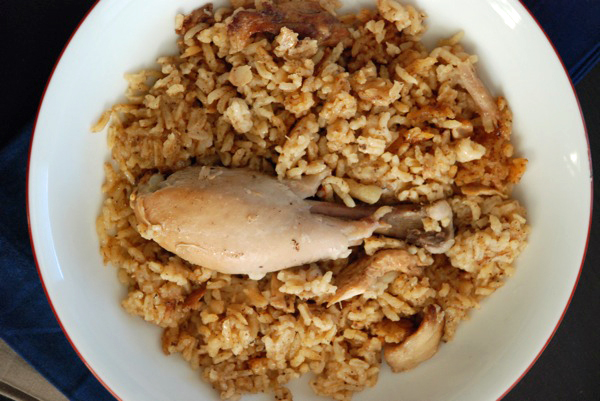In anticipation of my first post in 2011, I looked back at my last posts in 2009 and my first in 2010, to jolt my memory about where I was and what I was doing the last time I rang in a new year. Turns out, I was in Israel. Lucky me. I'm stateside this year, which, if you factor in the 12 hours I won't spend on a flight to get there, ain't half bad. We brought in 2011 with cocktails (lychee martinis, bourbon gingerale, the fancy stuff!) and appetizers (all sorts of delicious: we're talking lahmajoun, deli sliders, chicken wontons, coconut corn fritters, the works). I'm chasing the debauchery and excess of December 31st with a healthy, wholesome 1/1/11. This here is a recipe even the most stern-faced New Years resolution-makers will be able to enjoy.
Appropriately enough, my journey to the perfect mujaddara started with my two years in Israel. While I lived in Jerusalem, one of my favorite restaurants was an unassuming cafe attached to a small museum near the Old City. A sort of precursor farm-to-table eating, it specialized in local and organic food, but quietly and unpretentiously so. Nowhere on its menu did it say the restaurant was organic, but if you asked, you'd find out that the milk was from a local farmer, the eggs sometimes laid the same day they were eaten, and so forth. I don't know what it's like these days, but back then, it was a charming restaurant.
The restaurant's menu put modern spins on traditional dishes. I most adored their mujaddara, a Middle Eastern dish of long-grain rice and lentils with loads of caramelized onions. Though not particularly traditional, the restaurant's version included a bit of chutney and this amazing cumin-spiked yogurt. Try as I might to diversify my orders, once I had tried the mujaddara, I found it difficult to order much else. With yogurt, the mujaddara headed the way of great Indian buffet food. A little of this, a little of that, some chutney and raita, all mixed together on the plate. Perfection.
While my yogurt is slightly different in flavor than theirs -- more cinnamon, more citrus, no saffron -- it's addictive in its own right. Mujaddara is a minimalist's dish: it has no added spices. The lentils and rice, when adequately salted, need little more than soft, caramelized onions. But I find this yogurt adds just the right amount of tang to contrast the sweetness of the onions and prevents mujaddara from seeming too heavy. Plus, yogurt plops this dish squarely in healthfood territory. It's the perfect nightcap to this delicious, delightful year.
Update: I just learned that my Mujaddara has been selected as a finalist for the Food52 "best lentils" contest -- huzzah! To view the entry and vote, click over to Food52: www.food52.com.
Mujaddara with Spiced Yogurt
For the Mujaddara:
2 tablespoons butter 3 tablespoons olive oil 6 cups onions (about 3 medium onions), halved and thinly sliced 1 cup jasmine rice 3/4 cups puy lentils (aka French lentils, the tiny dark brown ones) 1 teaspoon salt, divided
For the yogurt:
1/2 cup greek yogurt 1/2 teaspoon cinnamon 1/2 teaspoon cumin (freshly ground, if possible) 1/2 teaspoon coriander (freshly ground) 1/2 teaspoon spicy paprika or aleppo pepper 3 tablespoons chopped fresh mint juice and zest of on half a lemon 1/4 teaspoon salt
Preheat the oven to 400 degrees.
Put lentils, 1/2 teaspoon salt, and 4 cups water in a large pot and bring to a boil. Reduce heat and simmer lentils until soft but not mushy, about 20 minutes. Drain lentils and set aside. Rinse pot.
Add rice, 1/2 teaspoon salt, and 1 1/2 cups water to the pot, set over medium heat, and bring to a boil. When water begins to boil, cover pot, transfer to oven, and cook for 17 minutes (the tried-and-true Amanda Hesser method!) until perfectly cooked. Remove from oven, uncover, and fluff with a fork. Set aside.
While rice cooks, set a wide, deep saute pan over medium-low heat and add butter and 2 tablespoons olive oil. When butter has mostly melted, add onions and toss to incorporate with butter and oil.
After 5 minutes, onions will have softened slightly and started to release their liquid. Raise heat to medium and cook about 10-12 minutes more, until onions are very soft and browned. Add water by the tablespoon if pan gets too dry or if onions start to stick. When onions are well browned, add last tablespoon of olive oil and raise heat to high. Cook another 3-4 minutes, until bottom layer of onions has charred and crisped; try not to stir too much, or onions won't crisp up.
Combine rice, lentils, and most of the onions in large serving bowl and let sit for at least 15 minutes, to marry the flavors together. (Truth be told, this dish improves with age.) Taste, and add more onions if desired. Meanwhile, make the yogurt: mix all ingredients together in a small bowl. (Yes, it's really that simple.)
If mujaddara has cooled significantly, reheat in a low oven or even in the microwave for a couple minutes. To serve, plate a big scoop of mujaddara and top with a dollop of yogurt.
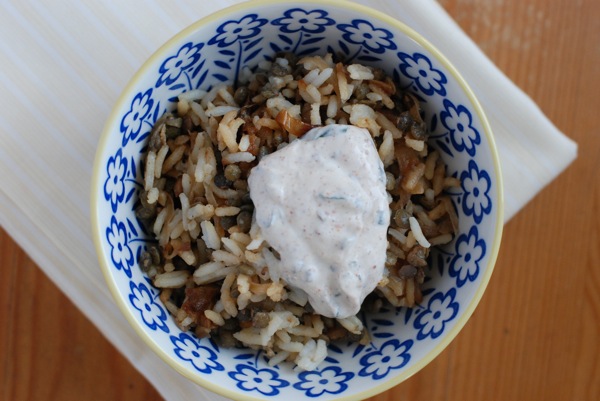
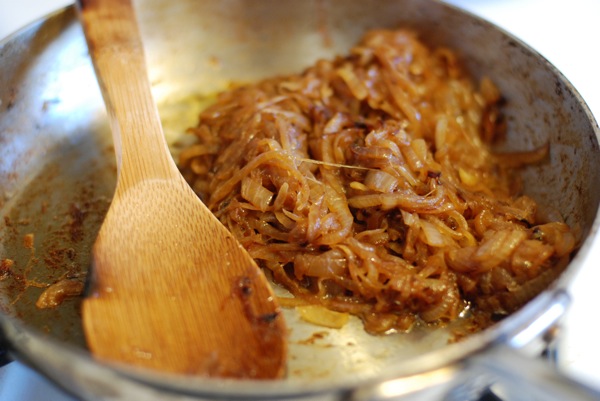

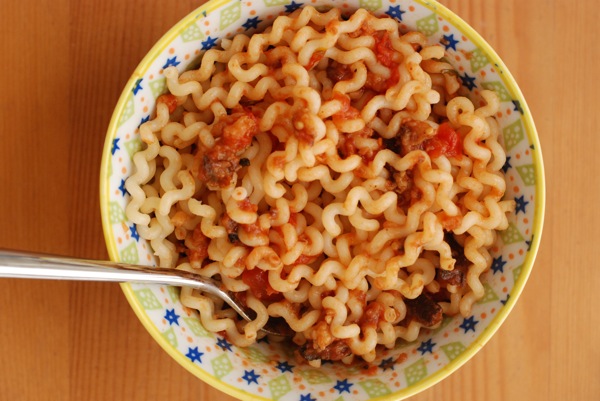 For most of you, this weekend was chock full of great food. I may not have had Christmas dinner, but I had a southern feast of fried chicken, pulled smoked beef, and collards that rivals the best Chinese takeout of my storied Jewish-Christmas past. Still, as I think back on the past couple weeks of eating, I tell you this with little hesitation: long fusilli with Marcella Hazan's Tomato-Eggplant sauce is the single best food item I've eaten in weeks.
For most of you, this weekend was chock full of great food. I may not have had Christmas dinner, but I had a southern feast of fried chicken, pulled smoked beef, and collards that rivals the best Chinese takeout of my storied Jewish-Christmas past. Still, as I think back on the past couple weeks of eating, I tell you this with little hesitation: long fusilli with Marcella Hazan's Tomato-Eggplant sauce is the single best food item I've eaten in weeks.